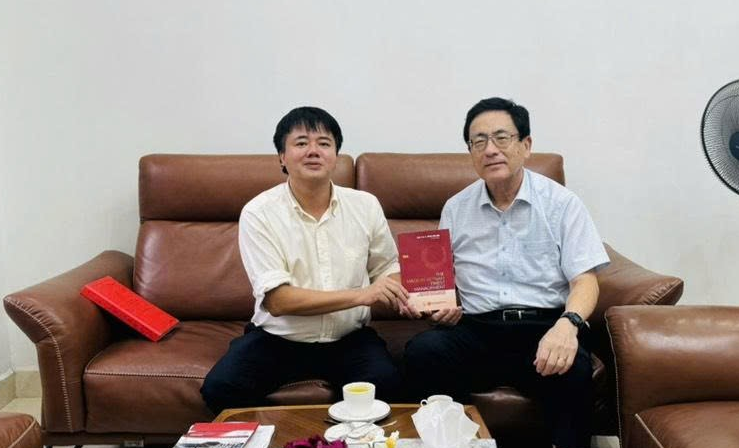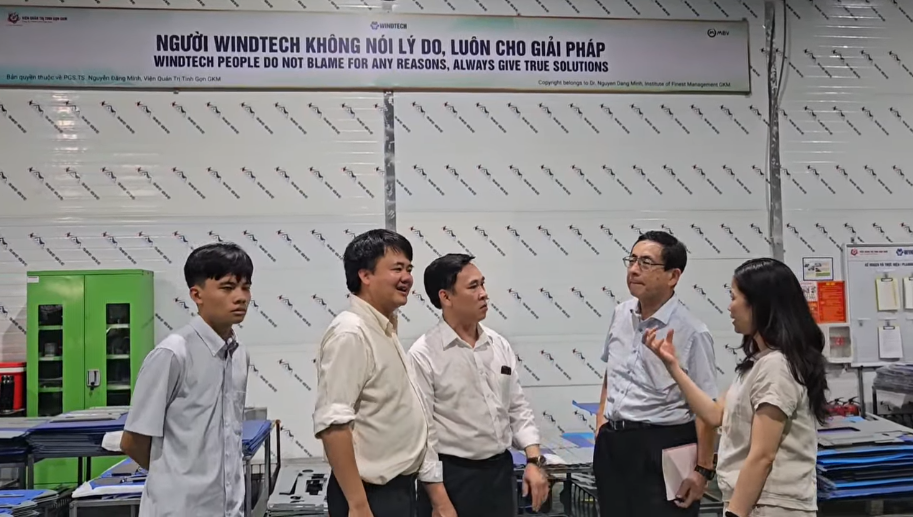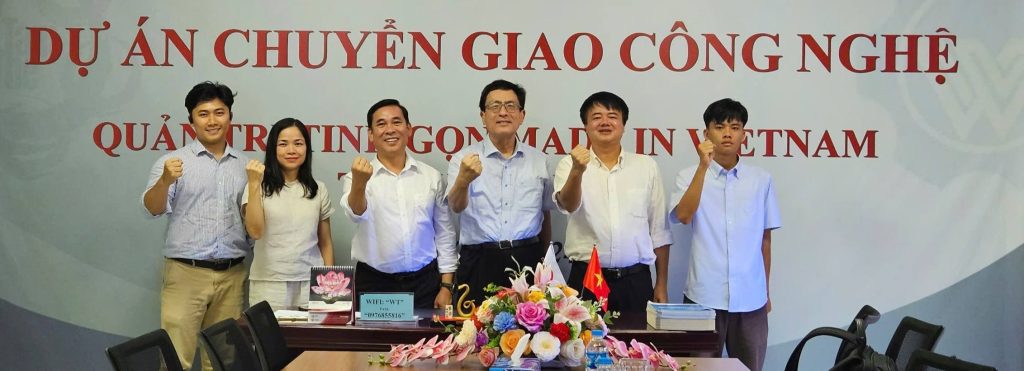Understanding the GKM Method
Strengthening Vietnamese Firms and Building New Bilateral Industrial Collaboration
Kenichi Ohno
Prof. Emeritus, National Graduate Institute for Policy Studies
July 15, 2025
The GKM Group is a private consulting firm established by Dr. Nguyen Dang Minh in Hanoi in 2015. It develops and applies a unique method to strengthen Vietnamese firms. Dr. Minh studied engineering in Japan with a Master of Engineering from Tokyo University and a Doctor of Engineering from Nagoya University. After working as a production management engineer at Toyota Headquarters in Aichi Prefecture, he returned to Vietnam to create this firm. His purpose was to develop a new consulting and training method suitable for Vietnamese society and culture with Japanese inputs, not a direct copy of the Japanese model. He is a gemba-based researcher and practitioner with a deep understanding of and high regard for Japan and its society. I first met him in 2008. Ever since, I have followed his methods and activities with great interest.

Dr. Minh runs GKM with a grand design and passion together with Ms. Giang, his wife who also studied in Japan, Mr. Toan, his brother, and dedicated colleagues who are fascinated by Dr. Minh’s method. Every few months, GKM organizes the CEO course to inculcate enterprise executives with a proper mindset and “The Made in Vietnam Finest Management” as well as the family course for raising children in a dynamic and disciplined way. Many attendants become excited about GKM’s method and CEOs often request direct consultation at their factories. For consultation, Dr. Minh and his teammates visit individual firms regularly to transform them with the new method. Ms. Giang visits individual families to teach 5S and kaizen. GKM also develops innovative school education programs. GKM has many activities and future plans and dreams, which are constantly changing and expanding. I am unable to catch up with all of them.

Professor Kenichi Ohno, Assoc. Prof. Dr. Nguyễn Đăng Minh, and the leadership team of Windtech Technology Joint Stock Company during their visit to Windtech.
What is the GKM method?
For many years, I have listened to Dr. Minh, read his book, and visited companies with him. Through these, I have a rough idea of how he improves companies but without understanding the details. This was partly because the details were his trade secret which he didn’t wish to disclose while he was in a trial-and-error process to firmly establish them, and partly because I didn’t have time to continuously observe his method at targeted companies. As GKM celebrates its tenth anniversary, Dr. Minh says that he can now unveil his secret details concerning his method. Honestly, I still don’t fully comprehend them even with his repeated explanations. But in my current understanding, it goes something like the following.
First, the Vietnamese people and the Japanese people are different. For the Vietnamese to correctly perform monozukuri (manufacturing with skill and dedication), they first need the proper Tam The (mindset) without which the introduction of productivity tools such as kaizen will not work. Copying of the Japanese model without local adjustment does not produce results. How GKM teaches Tam The to the Vietnamese cannot be understood unless one observes the entire process at the factory gemba. My understanding based on information I have collected suggests that it goes something like this.
(i) Confirm the strong commitment of the president of the company and receive full authority to implement the GKM method without interruption or meddling (without which the process will not start).
(ii) Gather middle managers and section chiefs of all departments and have a series of lectures and discussions on the new method.
(iii) Initially, opposition and skepticism may rule. But as sessions proceed, most will agree to “try the method if GKM is so confident.” Remaining opponents will be removed or demoted.
(iv) Managers and chiefs return to their sections and draft a standard operating procedure (SOP) by mobilizing all workers. GKM will monitor and advise on this work and encourage active participation of the workers.
This process is very different from the way Japanese firms and JICA experts teach 5S or kaizen. The Vietnamese seem to prefer full mobilization of the entire firm (not just selected individuals or production processes) as a mass movement to collectively transform everyone’s thinking and behavior. Through this, they learn to feel that they are the main players of the firm, become proud and happy about it, pursue the elimination of muda for high efficiency, and recognize that the firm makes progress when all work together. Dr. Minh once showed me a slide that taught workers, on leaving the factory after work, to walk on one side of the road instead of spreading out and blocking the road, with two contrasting photos. I don’t think Japanese workers need such an instruction before working at a factory.
Second, the most important element is people, not machines. This principle may be common in many countries, but people here specifically means the workers and their families. The mission of any firm is to pursue the benefits of employees, their families, the company, customers, and society at the same time. The traditional sampo-yoshi (trilateral benefits) of Omi merchants is maximizing the benefits of sellers, buyers, and society. The five-sided benefits described here propose that employees and their families should be accorded the highest priority. This is a new and unique principle.

Professor Kenichi Ohno, Assoc. Prof. Dr. Nguyễn Đăng Minh, and the leadership team of Windtech Technology Joint Stock Company during their visit to Windtech.
This proposal reflects the following psychological and cultural aspects of Vietnam. Vietnam is traditionally a village society where everyone participates, happily and without question, in village festivals, joint work, weddings, funerals, etc. However, upon coming to a factory, the same people become individualistic and selfish. Dr. Minh believes that this cultural gap should be amended by restoring the traditional community spirit in factories as well. This requires putting the teamwork, upward mobility, and benefits of the workers first before pursuing the benefits of the company, customers, and society. Japan also had the notion of “a company is a family” in the past, but this idea is no longer acceptable to young people. But in Vietnam, people still welcome the restoration and expansion of the community spirit at the factory.
Third, all employees must practice and strengthen SxQxCxDxE. Here, S means safety, Q is quality, C is waste cost reduction, D is on-time delivery, and E is environment. Safety and QCD need no additional explanation. E here includes not only standard environmental protection but creating the conditions where people (employees and their families) can fully utilize their capability and attain happiness. This again shows the prioritization of workers in enterprise management. GKM teaches the firm to maximize the product of the above five factors (multiplication principle). What is critically important is that each worker must learn these five factors and implement them in his or her assigned workplace. The production section and the quality control section should be integrated, and the separation of safety assurance and environmental protection into different staff is not advisable. This transforms each worker into a “manager” responsible for SxQxCxDxE. The idea is easily adopted by high school graduates but difficult to understand or accept for university graduates who have specialization and want to work in that narrow field only.
After the initial coaching of GKM, companies must continue the internal movement to sustain and strengthen these five factors. This includes, for example, chanting Tam The and SxQxCxDxE at the morning meetings of every section, forming study sessions, holding company-wide meetings and rallies, and inviting the family members of the workers to learn the new mindset and behavior. This method focuses on the feeling and excitement of the employees as the entry point for firm reform, which is different from the Japanese way of emphasizing gemba efficiency as a starter through 5S, kaizen, QCC, etc. Japanese and Korean workers may not need a psychological change but this step is explicitly and critically required in Vietnam. This comes from the different work cultures of individual countries. Vietnamese workers also learn 5S and kaizen, and factories are kept reasonably clean. But I feel that the perfect execution of seiri seiton or keeping toilets always shining is not the highest priority in Vietnam’s enterprise transformation.
Fourth, after Vietnamese companies are successfully transformed by the new method, GKM proposes a new bilateral industrial collaboration – “Collaboration 2.0”. Japanese firms are targeted but firms of other nationalities can also participate in this. The old model (Collaboration 1.0) consists of Japanese FDI firms bringing management, technology, and market to Vietnam and producing with local cheap and diligent labor. In a sense, this is win-win cooperation, but Japan acts with dominant knowledge and capability as a teacher and Vietnam is the receiving side as a student. Because the Japanese model does not work properly in another country, Japanese management must find a way to adjust the original model to fit Vietnam’s reality. This was an endeavor on the Japanese side only, and some companies succeeded and others failed. Bilateral industrial collaboration 2.0 advocated by GKM rejects the teacher-student relationship and encourages both sides to contribute their strengths to jointly create value. Specifically, Japan should bring production technology and market, and Vietnam should bring management technology and employee education (i.e., dynamic and efficient local enterprises and workers created by the GKM method). These are alternatively called MBV (Made by Vietnam) and MBJ (Made by Japan), the combination of which is the essence of Bilateral Industrial Collaboration 2.0
If this becomes reality, Japanese companies will no longer be required to make special efforts to guide and train local firms and workers. That will be the task on the Vietnamese side. The renovated features of Vietnamese firms are guaranteed to be compatible with the Japanese model (5S, kaizen, QCD, long-term orientation, etc.) because the GKM method replicates the good aspects of the Japanese model by a newly developed training procedure suitable for Vietnamese corporate culture. For Japan, this method and 2.0 Collaboration may become one of the key ways to build new and more equal relations with developing countries. This can also be a good example of translative adaptation, namely, the creation of a new Vietnamese model through appropriate local adjustments to a foreign model.
Challenges for further development
The mindset (Tam The) transformation, the prioritization of employees and their families, all-company movement, the restoration of community spirit in companies, the promotion of SxQxCxDxE, and Bilateral Industrial Collaboration 2.0 may collectively form a dynamic driver of Vietnamese firms and their alliance with foreign firms. They have the potential to contribute to Vietnam’s overcoming of a middle income trap, value creation along the Smile Curve, and becoming a high income developed country by 2045, provided that the GKM model is effective. The remaining challenges include (i) an increased recognition of the model’s effectiveness among the people and governments of the two countries; (ii) the successful transformation of many Vietnamese firms by this method which increases suitable partners for bilateral collaboration; and (iii) seeing this, many Japanese and other foreign firms positively enter into Bilateral Industrial Collaboration 2.0 with Vietnamese firms. Put differently, the GKM model has completed the “learning stage” and the “adaptation stage” in the importation process of a foreign model, and now faces the “diffusion stage.”

Professor Kenichi Ohno, Assoc. Prof. Dr. Nguyễn Đăng Minh, and the leadership team of Windtech Technology Joint Stock Company during their visit to Windtech.
The total number of Vietnamese firms that received GKM’s transformative support is about 1,000 which ranges from SMEs to large firms in various sectors. Among them, THACO AUTO is the largest and most famous firm producing THACO-brand commercial vehicles as well as engaging in the contract assembly of passenger and commercial vehicles for Mazda, Peugeot, BMW, Mitsubishi, and Kia. The top executives of THACO AUTO are highly appreciative of Dr. Minh’s guidance. Viettel Construction Company and Petrolimex, two other large firms, were also aided by GKM but only partially and temporarily. Other firms that experienced the positive impact of GKM support, as far as I know, include Le Group (metal parts), Manutronic (electronic parts), Thieu Do (Japanese suit products), AVC Crane (in-factory cranes), Windtech (metal frames and parts), AMECC (large construction parts), and Bao Minh (confectionery). Besides these, many Vietnamese firms, beyond my knowledge, in various sectors must have also learned much from GKM as GKM’s CEO courses have already been repeated dozens of times spreading the new model among entrepreneurs. Mr. Funayama Toru, the former president of Mitsubishi Corporation (Vietnam Branch), was one of the attendees who showed great interest in GKM’s method. With all these achievements, however, the recognition of the new method among the business, public, and academic circles in Vietnam and Japan is not yet very high.
In Japan, the national productivity movement in the late 1950s was backed by the strong interest of many firms, excellent support provided by industrial NPOs, many overseas study missions, and dissemination seminars after the return of these missions, which produced great changes nationwide within several years. The three-stage cycle of learning, adaptation, and diffusion was completed. Meanwhile, GKM’s activities at present are purely private, unaccompanied by others, with a relatively small budget and staff, and without visible support from the government or industrial NPOs.
GKM, now celebrating its tenth anniversary with substantial achievements, plans to open up its trade secret (details of its methodology) and reinforce its PR activities. The disclosed trade secret should in most parts overlap with what I have written above, if not perfectly match. As part of PR, Dr. Minh will do workshops in Tokyo and Nagoya this coming October. If both the reputation of his method and the number of successful client firms increase simultaneously and interactively, and cross a certain threshold, this method may create a tsunami of national enterprise movement in Vietnam. For this to happen, the preparation of dissemination materials, media channels, and supporting organizations as well as increased private and public recognition in Vietnam and Japan, are called for. As a first step, the disclosed trade secret must be presented effectively and concisely in pamphlets, academic papers, reports, presentations, websites, and the like.
This memorandum discussed how GKM transforms Vietnamese firms. Dr. Minh states that Vietnam needs improvement in enterprises, families, and the government. GKM has launched support programs for the first two but the third has not started. Under GS To Lam, Vietnam may have entered a new era where bold actions and reforms are executed. Administrative reforms are already in place. In the economic area, private sector development (PSD) has been officially recognized as one of the key objectives, but a concrete methodology has not been constructed. The GKM method developed by Dr. Minh may be one of the methods to energize Vietnamese enterprises.
[END]
 English
English




